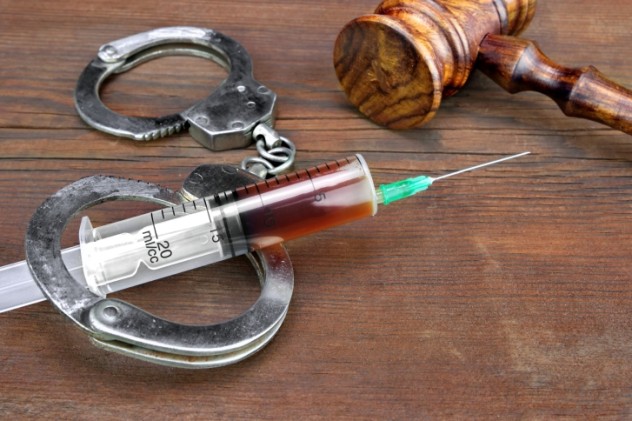 Creepy
Creepy  Creepy
Creepy  Movies and TV
Movies and TV 10 Movies That Get Elite Jobs Right, According to Experts
 Weird Stuff
Weird Stuff 10 Times Real Laws Were Based on Bizarre Hypotheticals
 Animals
Animals 10 Inspiring Tales of Horses Being Human
 Mysteries
Mysteries Top 10 Haunting Facts About the Ghost Ship MV Alta
 History
History 10 Surprising Stories About the Texas Rangers
 Humans
Humans 10 Philosophers Who Were Driven Mad by Their Own Theories
 Miscellaneous
Miscellaneous 10 Video-Game-Worthy Weapons and Armors from History
 Weird Stuff
Weird Stuff 10 Psychics Who Accurately Predicted Wartime Events
 The Arts
The Arts 10 Pieces of Art Inspired by a Broken Heart
 Creepy
Creepy 10 Death Superstitions That Will Give You the Creeps
 Movies and TV
Movies and TV 10 Movies That Get Elite Jobs Right, According to Experts
 Weird Stuff
Weird Stuff 10 Times Real Laws Were Based on Bizarre Hypotheticals
Who's Behind Listverse?

Jamie Frater
Head Editor
Jamie founded Listverse due to an insatiable desire to share fascinating, obscure, and bizarre facts. He has been a guest speaker on numerous national radio and television stations and is a five time published author.
More About Us Animals
Animals 10 Inspiring Tales of Horses Being Human
 Mysteries
Mysteries Top 10 Haunting Facts About the Ghost Ship MV Alta
 History
History 10 Surprising Stories About the Texas Rangers
 Humans
Humans 10 Philosophers Who Were Driven Mad by Their Own Theories
 Miscellaneous
Miscellaneous 10 Video-Game-Worthy Weapons and Armors from History
 Weird Stuff
Weird Stuff 10 Psychics Who Accurately Predicted Wartime Events
 The Arts
The Arts 10 Pieces of Art Inspired by a Broken Heart
10 Death Row Inmates Who Might Be Innocent
In his famous Commentaries On The Laws Of England, Sir William Blackstone wrote “It is better that 10 guilty persons escape than that one innocent suffer.” Yet just last year, a Stanford University study extrapolated from past trends to estimate that around 4 percent of death row prisoners will eventually be exonerated. Since there are currently just over 3,000 men and women on death row, that would suggest that roughly 120 Americans are facing death for a crime they didn’t commit. Here are 10 possible candidates.
10Robert Gene Will II

On the morning of December 4, 2000, 22-year-old Robert Gene Will II wasn’t exactly sitting at home minding his own business. Instead, he and his friend Michael Rosario were out stealing car parts in a suburban area near Houston. When two Harris County deputies caught them in the act, Will and Rosario split. Deputy Warren Kelly went after Rosario, while Deputy Barrett Hill chased Will down and subdued him, radioing, “4119, I’ve got one in custody.” Sixty seconds later, Will had a bullet wound to his left hand and Deputy Hill had been shot dead.
The official story, the one that landed Will on death row, is that Will produced a gun, shot Deputy Hill, and escaped. Will was subsequently arrested near Brenham, Texas, about 150 kilometers (90 mi) from Houston, in a car he’d stolen from a woman at gunpoint. The woman later claimed that Will had admitted to shooting Deputy Hill, although she made no mention of that in her statements immediately after the crime. In his defense, Will claimed that he couldn’t have shot Deputy Hill, since his hands were handcuffed behind his back at the time. Instead, he claimed that Rosario had returned and shot Hill.
Hill had been shot multiple times, but no trace of his blood was found on Will’s clothing. Gunshot residue (GSR) tests were inconclusive, finding trace amounts of GSR on Will’s left hand (where he’d sustained a gunshot wound), but none on his dominant right hand. The back of Will’s jacket had been grazed by a bullet, but Deputy Hill’s weapon was found in its holster and had not been discharged. A judge later wrote that there was a “total absence of eyewitness testimony or strongly probative forensic evidence” suggesting Will was responsible for the murder.
Meanwhile, several witnesses eventually came forward to say that Rosario had confessed to the killing. Prosecutors rejected this testimony, arguing that it should have been presented sooner and accusing Will of trying to bribe witnesses. They also argued that Rosario didn’t have time to circle back and shoot Hill. Rosario, the son of a well-known and well-liked Houston police officer, was never charged in Hill’s death.
Rob Will has been on death row since 2002. Grounds for future appeals include mistakes in his first trial and multiple errors made by his original lawyer, who was later discovered to be suffering from the early stages of Parkinson’s disease.
9Jarvis Jay Masters

Jarvis Jay Masters was serving time for armed robbery in San Quentin when Sergeant Howell Burchfield was murdered there in 1985. Even though Masters was in his cell at the time of the murder, he was charged along with two other inmates as part of a conspiracy to kill Burchfield. The “spear man” accused of the physical stabbing got life without parole, as did a second man involved. Masters’ alleged role in the murder was sharpening the bit of metal used to stab Burchfield. He was given the death penalty.
Masters belonged to the gang responsible for planning Burchfield’s death. However, some witnesses claimed he’d fallen out of favor with the gang after refusing to participate in the plan. The prosecution had three key witnesses who testified against Masters. All three later recanted their testimony. One witness claimed that he had been offered a light sentence in exchange for testifying against Masters. Another said that authorities gained his cooperation by threatening to send him back to San Quentin, where he was likely to be killed as an informer. One gang member even admitted to making the blade, but this evidence was never heard in court.
During the trial, a witness who said he was involved in the planning of the murder was asked to describe the three men who carried out the plan. None of the defendants were in the courtroom at the time. While the witness described the other two inmates with no trouble, he couldn’t give any details that matched Masters. When the defense requested a lineup to see if the witness could identify Masters, the request was denied.
Jarvis Jay Masters has been on death row since 1990.
8Donnis George Musgrove

When their stolen Camaro crashed at high speed, Donnis George Musgrove and David Walter Rogers were lucky enough to walk away. Well, actually they ran away, since Alabama sheriffs were right behind them. And when the sheriffs caught up, the high-speed chase and wrecked car turned out to be the least of their worries. Soon after the arrest, the two men were placed in a lineup and identified as killers by the widow of a murder victim.
That’s what the jury was told, anyway. In reality, Libby Barron originally told the police that she couldn’t tell if any of the men in the lineup were the same as the pair who had burst into her bedroom and shot her husband, Coy Eugene Barron. The room was dark and Libby was holding her baby in her arms when the men forced the door, which Coy had been trying to hold shut, and each fired one shot at Coy before fleeing. In all that confusion, she couldn’t get a good look at either of the intruders. However, after speaking with one of the detectives working the case, Libby came back for a second look at the lineup. On that occassion, she selected Musgrove and Rogers without hesitation.
Musgrove and Rogers were convicted based on Libby’s identification and a shell casing supposedly found at the scene of the murder, which matched Musgrove’s gun. However, scientific tests have since indicated that the shell casing was unconnected to the guns used in the murder. Musgrove’s lawyers claim it was planted. They also claim phone records indicate Musgrove was in Florida at the time of the crime. Other than the lineup and the shell casing, all that ties Musgrove and Rogers to the murder of Coy Barron is the recanted testimony of a jailhouse informant.
David Walter Rogers died of natural causes while awaiting execution. Donnis George Musgrove has been on death row since 1986.
7Louis Castro Perez
In September 1998, Travis County police arrived at the Texas home of Cinda Barz. They had been called by Barz’s boyfriend, who had grown alarmed after being unable to contact her, even though her car was parked outside the house. When the cops gained entry to the home, they found Barz lying in a pool of blood in the front hallway. She had been severely beaten and stabbed. Barz’s roommate, Michele Fulwiler, was found strangled to death in her bed. Barz’s nine-year-old daughter, Staci, was found in her mother’s bed, tied up with a pair of nylons. She had also been strangled to death.
The last person known to have seen Michele Fulwiler alive was her friend Louis Castro Perez. He’d been seen at the home two nights earlier, drinking, snorting cocaine, and watching TV with Fulwiler, and had apparently slept at the house that night. Fulwiler called in sick to work at around 8:15 that morning. The bodies of Fulwiler and Barz had been covered with blankets and the door to Barz’s bedroom, where Staci was found, had been closed. To police, this suggested that the killer had known the victims. A bloody palm print next to Barz’s body was shown to belong to Perez, and his fingerprints were found throughout the home. His DNA was on a cloth found wrapped around a bloody knife. This was enough for a jury to convict Perez of the murders.
The most damning evidence was the palm print, which was the only thing suggesting he’d been in the home after the murders (the DNA and fingerprints were easily explained by his spending the previous night at the house). By way of explanation, Perez claimed that he’d gone to the home that day looking for Fulwiler and found Barz, badly injured and incoherent, on the floor. He got down onto the floor to check on her, but she’d scratched at his face. Terrified that Barz’s attacker might still be in the house, Perez left. He did not call the police because he had cocaine on him and there was a warrant out for his arrest.
Perez’s fingerprints were not the only ones found at the scene. Police found 43 other unidentified prints, but they were never sent to be examined. An unknown DNA sample, not matching Perez or any of the victims, was also found on the cloth wrapped around the knife and on a towel at the scene. Three items that may have been used against the victims—a frying pan, a phone cord, and a pair of nylons—showed no signs of fingerprints or DNA belonging to Perez. There is a simple explanation for why so much of the DNA was unidentified: the lab had been instructed to look only for Perez’s DNA. Whether the jury heard that explanation is uncertain, as members were observed sleeping during the trial.
Louis Castro Perez has been on death row since 1999.
6Rodney Reed
On April 23, 1996, 19-year-old Texan Stacy Stites left her home for work before dawn. At about 5:00 in the morning, a coworker called Stites’s mother to ask why Stites hadn’t come in for her shift. Before sunset that day, Stites’s lifeless body had been found on the roadside. She had been sexually assaulted and strangled with a belt. Her fiance’s truck, which she had taken when she left for work that morning, was found in a parking lot a short distance away.
Suspicion initially fell on her fiance, a rookie police officer named Jimmy Fennell, until DNA evidence collected from Stites’s body was connected to a suspect in another sexual assault case. That suspect, 28-year-old Rodney Reed, initially claimed he didn’t know the victim. When presented with the DNA evidence, Reed changed his story, claiming he had been having an affair with Stites in the five months prior to her death.
Of course, nobody bought that. The prosecution’s version of events is that Reed flagged Stites down as she drove Fennell’s truck to work. He then overpowered her, sexually assaulted her, and killed her. After dumping her body, he abandoned the truck and walked home. But witnesses who could testify to the affair were never called at Reed’s trial, nor were two alibi witnesses. With nothing to refute the DNA evidence, no one to place him anywhere other than the crime scene, and facing an all-white smalltown jury, Reed was quickly convicted.
However, some disturbing information about Jimmy Fennell has subsequently come to light. A witness testified that she heard Fennell saying that he would strangle Stites with a belt if she ever cheated on him. The apartment they shared was never searched after Stites’s death and DNA evidence unconnected to Reed was not submitted. The belt believed to have been used to strangle Stites was never tested for DNA. The Innocence Project is working to get all of the evidence tested.
Jimmy Fennell is currently serving a 10-year sentence for an unrelated sexual assault. Rodney Reed has been on death row since 1998.
5Tyrone Noling

As a thief, 18-year-old Tyrone Noling was something of a failure. In April 1990, he and an accomplice robbed two elderly couples at gunpoint. During one of the robberies, Noling’s gun discharged into the floor and he immediately checked that the couple were okay. One of the victims described him as a “scared rabbit.” He was snared within a week of the crimes, but the robbery he committed on April 5 wasn’t the only crime that went down that night.
A few miles away, another elderly couple, the Hartigs, had been assaulted and murdered in their home. Since Noling was known to be robbing couples in the area, he unsurprisingly became the prime suspect. Investigator Ron Craig couldn’t find any physical evidence, but he managed to persuade a few witnesses to come forward, although their testimony didn’t line up with the facts of the crime. It took five years to get the conviction, after which all of the witnesses recanted their testimony.
Meanwhile, a teenager named Nathan Chesley told school officials that his foster brother, Dan Wilson, had confessed to murdering the Hartigs. Chesley’s principal reported the story to the authorities, but the police never followed up. Shortly afterward, Dan Wilson was arrested for murder. Assuming it was related to the Hartig case, Nathan put the matter out of his mind. But when Wilson was executed in 2009, Nathan was surprised to learn that his brother had only been charged in an unrelated murder case. He was even more surprised to learn that Tyrone Noling had been on death row for the crime for 15 years. In other words, if Tyrone Noling was tried today, there would be no witnesses, no physical evidence, and a credible alternate killer.
Tyrone Noling has been on death row since 1995. In September 2015, the Ohio Supreme Court agreed to hear his appeal.
4Darrell Lomax

Darrell Lomax was in the backseat of a car that was pulled over for an illegal lane change. When two handguns were found in the car, Lomax suddenly found himself subjected to a curbside gunshot residue test, which took two hours. He passed—no evidence was found that he’d recently fired a gun. During the course of the traffic stop, several patrol cars brought to the scene witnesses of two earlier crimes, asking if Lomax was involved. None of the witnesses implicated him in either incident. Along with the driver and other passenger of the vehicle, Lomax was still arrested and charged in connection with two armed robberies, one of which ended in the fatal shooting of Nasser Akbar.
Lomax was held from September 1, 1994, until March 13, 1995. On that morning, all charges against Lomax were dropped, but the case against him proceeded anyway, even though the prosecution did not formally refile the complaint or rearrest Lomax. This was technically a violation of the penal code, but Lomax wasn’t informed that the charges had briefly been dropped until years later. In the meantime, he was found guilty, based largely on the testimony of Angela Toler, the other passenger in the vehicle Lomax had been riding in. Toler recieved a lighter sentence in return for her testimoney.
No physical evidence connects Lomax to the murder of Nasser Akbar. No gunshot residue was found on him at the time and his fingerprints were not on either gun. A surviving witness to the robbery stated that there were two assailants: a woman, and a man with dreadlocks, which Lomax did not have. Another witness cleared Lomax in the initial field identification, but later changed his story to match Toler’s. In return, the authorities dropped $1,600 in unpaid parking tickets and a charge for possession of an unregistered handgun against the witness (the official explanation was that authorities were eager to prevent the witness from going to prison, where his life might have been in danger). Prior to the trial, the witness never gave any descriptions that matched Lomax.
Darrell Lomax has been on death row since 1995.
3Kevin Cooper
Like many of the people on this list, Kevin Cooper can in no conceivable way be considered an innocent man. When the Ryen family of Chino Hills, California, were slaughtered in their home, Cooper was hiding out in a nearby empty house. He had previously escaped from the California Institution for Men, where he was serving a sentence for burglary and was facing charges for rape and kidnapping. On June 4, 1983, Bill Hughes arrived at the Ryen house to pick up his 11-year-old son. To his horror, he found his son dead, along with Douglas and Peggy Ryen and their 10-year-old daughter, Jessica. Eight-year-old Joshua Ryen clung to life, despite having his throat slashed.
In total, the five victims had no fewer than 140 injuries, inflicted with an ice pick, a hatchet, and at least one knife. The murders were so brutal, investigators thought they had to be cult-related. The focus shifted to Cooper after evidence confirmed he had been hiding nearby. In the meantime, Cooper had fled to Mexico, where he was eventually captured. He was soon found guilty and sentenced to death.
However, there were some reasons to doubt his guilt. Most compellingly, a woman named Diana Roper told local sheriffs that her boyfriend, a convicted hitman named Lee Furrow, had left a pair of bloody coveralls at her house on the day of the murders. She said Furrow had been wearing a tan shirt earlier in the day, but wasn’t wearing it when he dropped off the coveralls. A bloodsoaked tan shirt was found a short distance from the crime scene. However, detectives investigating the case ignored Roper and never even bothered to pick up the bloody coveralls from her local police station. The local cops ended up throwing them away months later. They have not resurfaced.
Defense lawyers also pointed out that the killer was in no rush to leave—even drinking a beer from the fridge—but Peggy Ryen’s purse was left untouched on the counter. Cooper had been calling his old girlfriends asking for money to fund his escape. They all refused, so why would he leave the cash in the purse untouched?
Some advocates for Cooper’s release have also made much of a statement by Josh Ryen, who told a deputy sitting in his hospital room that Cooper wasn’t the killer and that three men had attacked the family. However, Josh later said he never got a good look at the killer. He had seen three Mexican men near the house earlier in the day and merely assumed they had carried out the crime. He now strongly believes Cooper attacked his family. DNA testing in 2001 linked Cooper to a blood drop found at the scene, although his lawyers point out that the police initially said the blood had been destroyed in the initial testing, only to suddenly find another sample 15 years later.
Kevin Cooper has been on death row since 1985.
2Thomas Arthur

Thomas Arthur is certainly guilty of murder, but perhaps not the one that got him to death row.
In 1977, Arthur barged into the office where his sister-in-law worked, demanding that she tell him where his wife was. When she refused, Arthur shot her to death and injured another woman in the office. He was found guilty of murder and sentenced to life in prison. He was participating in a work release program when he became romantically involved with Judy Wicker.
A short time later, Wicker’s husband, Troy, was murdered in their home. Wicker told the cops that a black man had broken in, shot Troy, then beaten and raped her before knocking her unconscious. Her story quickly fell apart, and she eventually admitted that she had arranged Troy’s murder. The hit man had worn an afro wig and blackface during the murder, and Wicker later paid him $10,000 of her $90,000 insurance settlement. That hit man, Wicker claimed, was Thomas Arthur. Since Arthur was already a known murderer, he was a believable suspect, and a jury sent him to death row based on Wicker’s testimony, a conviction that was ultimately upheld after being overturned and retried three times.
In 2008, Bobby Ray Gilbert came forward to admit that he, not Arthur, had committed the crime. At the time of the murder, Gilbert had been a minor, and he only confessed after the US Supreme Court ruled that a minor could not be given the death penalty. There is currently no physical evidence tying Arthur or Gilbert to Troy Wicker’s murder. The wig worn by the murderer had been tested for DNA, but none belonging to Arthur or Gilbert was found. And Judy Wicker’s rape kit, which could have definitively identified her killer, has been missing for years.
Arthur’s pro bono attorneys are currently fighting for additional DNA testing on the wig. New developments in forensic technology may allow scientists to find samples too small be detected by previous tests. Despite Arthur’s legal team offering to pay for the testing, the Alabama court system is dragging its feet.
Thomas Arthur has been on death row since 1982.
1Darlie Routier
In the early morning hours of June 6, 1996, 26-year-old Darlie Lynn Routier lay on an operating table in Dallas, fighting for her life. Doctors had performed surgery on her neck following a brutal attack that killed two of her three sons: five-year-old Damon and six-year-old Devon. Darlie’s own injuries came within 2 millimeters of severing her carotid artery, a wound that would have taken her life in minutes. Less than two weeks later, Darlie was arrested for killing her children.
According to Darlie, she and the two boys had fallen asleep in the living room with the TV on while her husband, Darin, and infant son, Drake, slept upstairs. She woke up when a strange man jumped on top of her and slashed at her with a knife. Despite sustaining injuries to her arm and neck, she was able to fight off her assailant and followed him as he fled through the utility room and out a garage window. During his escape, the assailant dropped his knife, which Darlie picked up. When she returned to the living room, she realized her children had also been attacked and called 911.
Police quickly identified problems with Darlie’s story. While a window screen in the garage had been cut out, it seemed to have been cut from the inside. The amount of blood on the scene would have made it impossible for the attacker to have escaped clean, yet there was no blood found outside the home. Doctors said Darlie’s wounds could have been self-inflicted.
At trial, much was made of Darlie’s behavior after the attack. Emergency personnel claimed that she never asked about her sons, but made a point of saying that she’d picked up the knife after the attacker had dropped it. Jurors were shown a video taken eight days after the attack, on what would have been Devon’s seventh birthday, in which Darlie appeared laughing, smiling, and spraying silly string over the boys’ graves. Prosecutors described her as “literally dancing on their graves.” Routier said the footage was taken out of context from a two-hour video of a somber memorial service, in which she had smiled and sprayed silly string in the belief that Devon might be watching from Heaven. Nonetheless, she was found guilty and sentenced to death.
Nobody has been able to adequately explain why Darlie would kill her sons. She had no apparent mental health issues and no motive for the attack. The family was having money worries, but the life insurance payout didn’t even cover the cost of the funerals. Additionally, there is evidence indicating that someone else may have been responsible for killing Devon and Damon.
Most notably, a bloodsoaked sock was found in an alley a considerable distance from the house. Prosecutors were never able to adequately explain the sock. They eventually suggested Darlie must have planted it to throw them off the scent. But Darlie only had a two-minute window between Devon’s stabbing and her call to police. It would have been almost impossible to sprint to the alley, plant the sock, return to the house, and then stab herself twice in that time. Interestingly, Darin Routier later admitted he had approached people to break into his home as part of an insurance scam.
Darlie Routier has been on death row since 1996.
Emily is a perpetually blocked writer, offbeat traveler, and armchair justice advocate.








